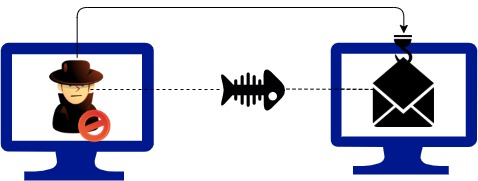The use of the internet is growing day by day and cyber attacks are also increasing rapidly with this rapid increase. As we talk of cyberattacks, they’re many and they’re of different kinds. Phishing is just one of those. About one-third of all breaches contribute to phishing. It is widely used by attackers because, it is simple, effective & inexpensive. You can easily get email addresses from any source, and emails sending are virtually free.
For example, Suppose a person is looking for a job, after all the attempts he’s unable to get a job. He has an overwhelming need for a job to make his living. Suddenly, he received a mail stating the “urgent need of a male worker in ABC Ltd”, after seeing the mail, a person clicks on the mail to find out more about the job and this is the trap point, as it gives the attacker all his personal information by a single click. Attackers target the person’s weak point and the person falls into it, because of his need.
Attackers can get quick access to valuable data with little effort and little expense. Those who fall into this can suffer from malware infection (like, ransomware), identity theft, and loss of data. There is a need, therefore, to protect yourself and to be aware of phishing attacks. Thus, stop being the attacker’s fish.
So, what’s phishing exactly?
Phishing
The mechanism of collecting personal or confidential information through the use of misleading emails and websites is known as Phishing. It can also be described as a fraudulent attempt to access information that is sensitive in nature, such as username, passwords, and details of bank card. It’s the kind of cyber attack that deceives people.
Phishing Types
- Spear Phishing – It is a target-based Phishing method. Basically, aimed at a particular person or an organization.
- Clone Phishing – Under this type, usually the attackers clone legitimate and previously deliver emails with links or attachments.
- Whaling – It seeks high-value targets, mostly senior executives or CEOs.
- Vishing/Phone-based Phishing – The phisher calls as a representative of the bank, police, or any government authority and threatens the user with any kind of issue, and insists on sharing their personal or sensitive information.
- Filter Evasion – Phishers used images instead of text to make phishing filters irrelevant.
- Link Manipulation – Deceived people by designing links similar to the links of their bank, or that go directly to the site of the phisher.
Identifying Phishing Emails
- If the mails contain incorrect spelling.
- When the emails contain the word like “Beware” or “Urgent.”
- If the mail contains attachments or links that are unusual or unexpected.
- When you don’t know the sender and the information is meaningless.
- If the mail includes choices such as “Act Now,” “Tap,” “Subscribe or Unsubscribe”.
Prevention
- Always check the spellings.
- Avoid open any odd or unexpected ties or attachments.
- Never upload your personal details to any social site.
- If the mail looks suspicious, please contact the source instead of any response.
- Checks the source content of the mail.
- Never hit buttons like click, subscribe, or unsubscribe.
Conclusion
The motive behind phishing emails is to deceive people to get their personal information. It’s just like that, the fisherman drops a hook bait in the sea to catch the fish. If you don’t want to be an attacker’s fish, then you need to protect yourself against these kinds of attacks by creating awareness within yourself.
In case of any help or query, please contact us or raise a ticket.



Be the first to comment.